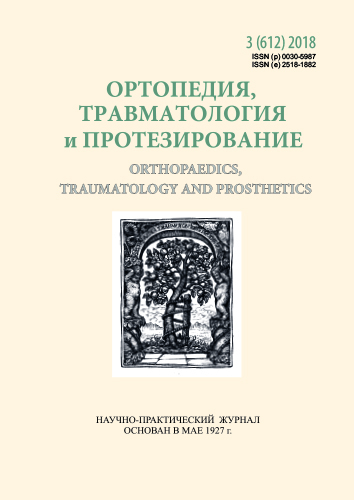Stress-strain state of the flat-valgus foot model in case of implants usage for subtalar arthrorisis
DOI:
https://doi.org/10.15674/0030-59872018374-79Keywords:
flat-valgus foot deformity, correction, arthrorisis, modelingAbstract
The flat-valgus foot deformity is one of the most common pathologies of the bone-joints system. flat-valgus foot deformity leads to the development of hallux valgus, excessive torsion of the crus, valgus deformation at the ankle and knee joints.
Objective: to analyze the stress-strain state of the foot elements in the case of the results of experimental lumbar posterior-lateral fusion with platelet rich fibrin and after its correction with screws for subtalar arthroris.
Methods: a biomechanical (mathematical) study was made with the finite element method on the foot model in normal and with The results of experimental lumbar posterior-lateral fusion with platelet rich fibrin. We performed subtalar arthroris with corrective screws, implanted into the calcaneus or talus bones.
Results: in case of the results of experimental lumbar posterior-lateral fusion with platelet rich fibrin increases the level of stress in all the elements of its bone model, especially on the supporting surfaces of the calcaneus and the surfaces of subtalar joint. At screws fixation there are two areas of high stresses (in the contact of the bone elements of the model with screws) with absolute values exceeding the parameters of the model with the results of experimental lumbar posterior-lateral fusion with platelet rich fibrin. Strain distribution was almost equal in cases of screw implantation in the calcaneus or talus bones. The highest stresses in the talus (12.5 MPa) were lower in the model with screws implanted into the calcaneus (11.1 МПа), so this option can be considered to be better.
Conclusions: usage of screw for subtalar arthrorisis allows to reduce stresses compared to the model with implants for arthroeresis, with the exception of contact points of bone with screws.
References
- Harris, E. J., Vanore, J. V., Thomas, J. L., Kravitz, S. R., Mendelson, S. A., Mendicino, R. W., Silvani, S. H., Gassen, S. C. (2004) Diagnosis and treatment of pediatric flatfoot. Journal of Foot and Ankle Surgery, 43(6), 341–373. doi: 10.1053/j.jfas.2004.09.013
- Gould, N., Moreland, M., Alvarez, R. [et al.] (1989) Development of the child’s arch. Foot Ankle, 9(5), 241–245.
- Morley, A. J. (1957). Knock-knee in Children. BMJ, 2(5051), 976–979. doi:10.1136/bmj.2.5051.976
- Mosca, V. S. (2010). Flexible flatfoot in children and adolescents. Journal of Children's Orthopaedics, 4(2), 107–121. doi:10.1007/s11832-010-0239-9
- The longitudinal arch. A survey of eight hundred and eighty-two feet in normal children and adults. (1987). The Journal of Bone & Joint Surgery, 69(3), 426–428. doi:10.2106/00004623-198769030-00014
- Sheikh Taha, A. M., & Feldman, D. S. (2015). Painful flexible flatfoot. Foot and Ankle Clinics, 20(4), 693–704. doi:10.1016/j.fcl.2015.07.011
- Giannini, S. (1998). Operative treatment of the flatfoot: why and how. Foot & Ankle International, 19(1), 52–56. doi:10.1177/107110079801900111
- LeLi, J. (1970). Current concepts and correction in the valgus foot. Clinical Orthopaedics and Related Research, (70), 43-55. doi:10.1097/00003086-197005000-00005
- Magnan, B., Baldrighi, C., Papadia, D. et al. (1997) Flatfeet: comparison of surgical techniques. Result of study group into retrograde endorthesis with calcaneus-stop. Italian Journal of Pediatrics Orthop., 13, 28–33.
- Beguiristain-Gúrpide, J. L. Lógica Clínica en Cirugía Ortopédica de la Parálisis Cerebral. Revista de neurologia, 37(1), 51–54.
- Agapov, V. P. (2000) finite element Method in statics, dynamics and stability of thin-walled spatially reinforced structures: textbook. Moscow: Publishing house. (in Russia)
- Berezovskyi, V. A., & Kolotilov, N. N. (1990) Biophysical characteristics of human tissue: Directory. Kiev: Naukova dumka. (in Ukraine)
- Gere, J. M., & Timoshenko, S. P. (1997) Mechanics of Material. Boston: PWS Publishing Company.
- Zenkevich, O. K. (1978) Finite element method in engineering. Moscow: Mir. (in Russia)
- Alyamovskii, A. A. (2004) SolidWorks/COSMOSWorks. Engineering analysis by finite element method. Moscow: DMK Press. (in Russia)
- Korolkov, O., Rakhman, P., Karpinsky, M., Shishka, I., & Yaresko, O. (2018). Characteristics of stress-strain foot model before and after subtalar arthroereisis with implants at the treatment of flatfoot (message 2). Orthopaedics, Traumatology and Prosthetics, 1, 65-71. doi:http://dx.doi.org/10.15674/0030-59872018165-71 (in Ukraine)
Downloads
How to Cite
Issue
Section
License
Copyright (c) 2018 Oleksandr Korolkov, Paviel Rakhman, Mykhaylo Karpinsky, Igor Shishka, Oleksandr Yaresko

This work is licensed under a Creative Commons Attribution 4.0 International License.
The authors retain the right of authorship of their manuscript and pass the journal the right of the first publication of this article, which automatically become available from the date of publication under the terms of Creative Commons Attribution License, which allows others to freely distribute the published manuscript with mandatory linking to authors of the original research and the first publication of this one in this journal.
Authors have the right to enter into a separate supplemental agreement on the additional non-exclusive distribution of manuscript in the form in which it was published by the journal (i.e. to put work in electronic storage of an institution or publish as a part of the book) while maintaining the reference to the first publication of the manuscript in this journal.
The editorial policy of the journal allows authors and encourages manuscript accommodation online (i.e. in storage of an institution or on the personal websites) as before submission of the manuscript to the editorial office, and during its editorial processing because it contributes to productive scientific discussion and positively affects the efficiency and dynamics of the published manuscript citation (see The Effect of Open Access).














